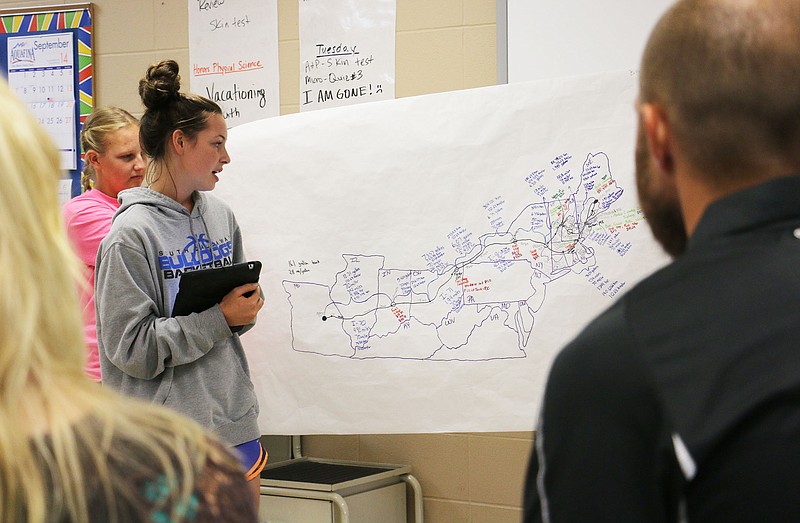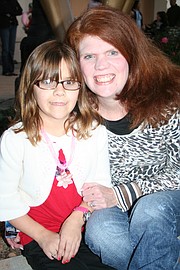
South Callaway High School freshman Ellie Dunnavant spoke on behalf of her group in front of the class Wednesday afternoon. The group presented its plans for a hypothetical vacation as part of a project-based learning unit (PBL). Their project was one of the first PBLs presented this school year. PBL focuses on critical thinking and problem solving, which the school is hoping will help increase its test scores.
South Callaway High School saw a few minor drops and small increases in its Missouri Assessment Program (MAP) End of Course (EOC) exams from 2013-14. High School Principal Heather Helsel described the school's EOC exam scores as "level" for the past several years. However, the school wants to see larger increases.
"We are doing things very well. We are in what you would might call a good performance, but we are really working to get to that great achievement performance," Helsel said. "That's moving more of our students from basic into the proficient range. We have not had any major drops or leaps over the last five years."
The high school's largest decrease this year from last year in the percent of students who scored proficient or better was in biology 1. In 2014, 52.6 percent of students scored proficient, compared to 57.7 in 2013. And 8.8 percent scored advanced in 2014, compared to 18.6 percent the year before.
The high school's largest increase this year from last year in the percent of students who scored proficient or better was in government. In 2014, 42.3 percent of students scored proficient in the subject compared to 37 percent in 2013. And 12.7 percent scored advanced this year compared to 12.3 last year.
"The teachers at South Callaway look at this (the test scores) and of course it's a representation of their instruction," Helsel said. "And they would like to see some bigger jumps."
High School teachers are are currently looking at ways to incorporate the EOC exams into the school's grading system.
"We are wondering if putting a little more high stakes for student accountability in their performance would give us the increases that we are looking for," Helsel said.
Teachers will present some ideas to the district's board of education at the next board meeting Oct. 8. The teachers will show data for South Callaway as well as for other districts who do attach the EOC exams to their school's grading system.
In doing research for that presentation, Helsel said South Callaway High School discovered that it is the only school in their conference and in their area that don't attach a grade to the EOC exam.
The EOC score was previously 10 percent of students' semester grade. The school stopped giving a grade four years ago. Helsel said there was a perception that there was an inconsistency in how the grades were being documented.
Since then, the high school has not noticed an impact on EOC exam scores. Helsel said the school doesn't have enough data prior to assigning a grade four years ago to see how assigning a grade affected scores. Since the school stopped giving a grade for the EOC exams, it has offered other incentives for good scores such as field trip days.
"The MAP ... That is total teacher accountability," Helsel said. "It (attaching a grade to EOC exams) is just a piece to incentivize students to perform their very best."
Helsel said the school and district has made some changes that could help raise test scores in the future.
Students received iPads last year and each building now has an instructional coach, a peer in each school who helps teachers utilize technology in the classroom. The instructional coaches have other teacher support responsibilities, which include helping with PBL's.
Dunnavant and her classmates' hypothetical vacation plans included how fast they would drive, how much gas they would use and how much the total trip would cost, taking into account all expenses. The class' teacher Carrie McDonald said the assignment required the students to investigate velocity, distance and time.
"It (the lesson on velocity, distance and time) is very applicable to life, but they don't see it when you just use formulas day in and day out," McDonald said.
Helsel said PBL's and better technology integration can help increase future test scores.
"Everybody is always concerned about doing their very best. Everyday, we are looking to improve," Helsel said. "That's not just a focus of the administration but it's a teacher focus and we feel we empower students everyday for that to be their focus - to make everyday the best day that they can."
The data
*There is no data available or the data is too small to report.
*There is no data available or the data is too small to report.
*There is no data available or the data is too small to report.
*There is no data available or the data is too small to report.


